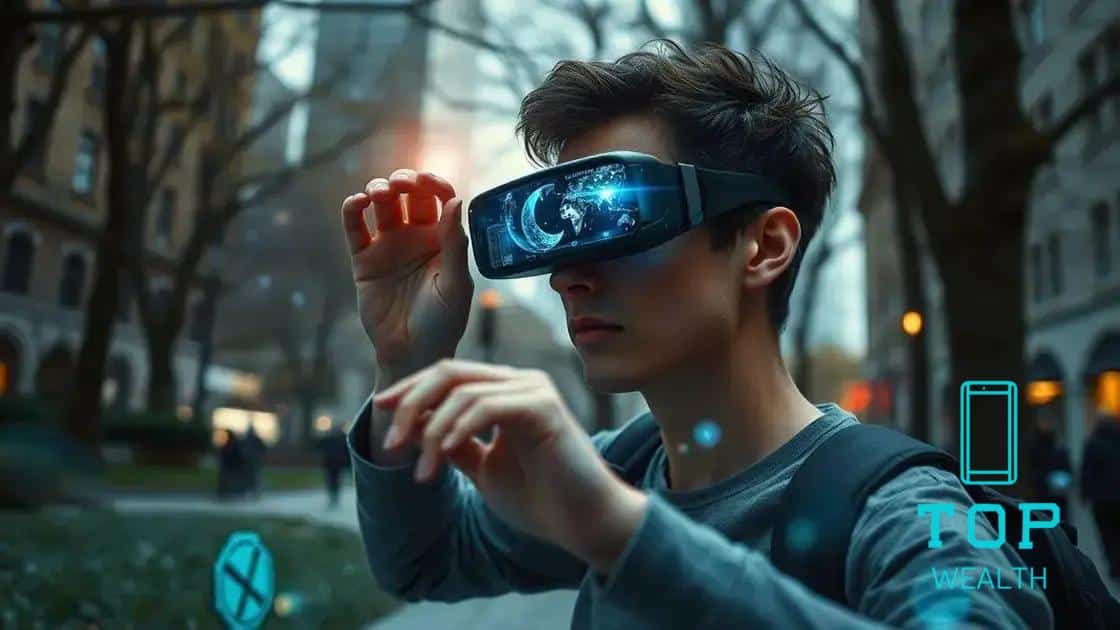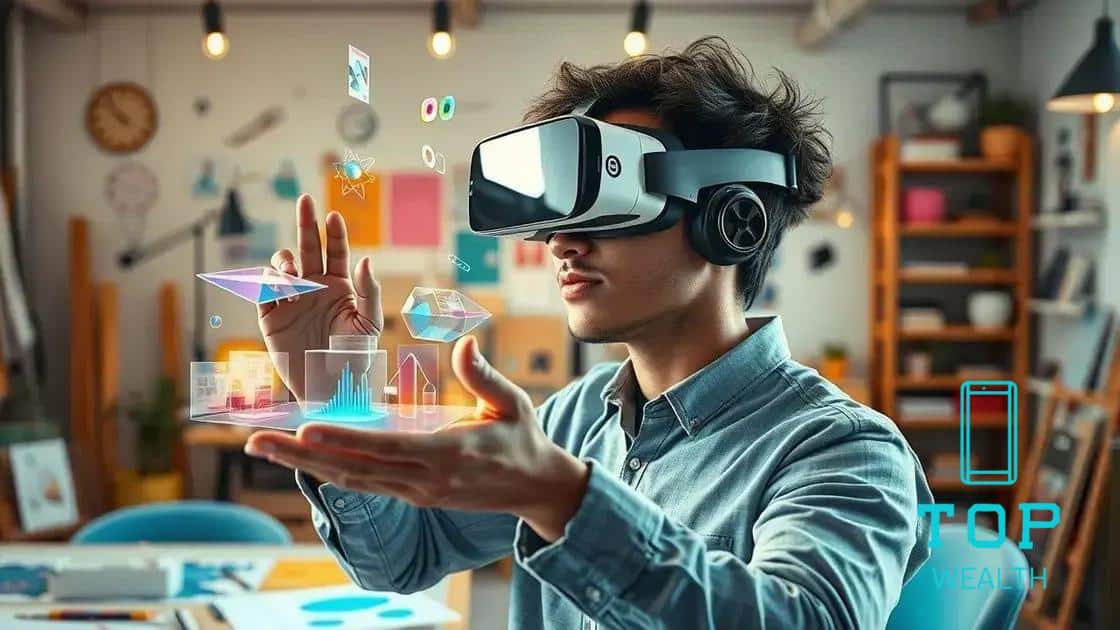Next-gen spatial computing redefines digital interaction

Next-gen spatial computing redefines digital interaction by merging the physical and digital worlds, enhancing user experiences through augmented and virtual reality technologies across various industries.
Next-gen spatial computing is changing the face of digital interaction. Imagine navigating your surroundings with 3D visuals that blend seamlessly with reality—sounds intriguing, right? Let’s dive into how this technology shapes our future.
Understanding spatial computing
Understanding spatial computing is crucial as we enter a new era of technology. This innovative field blends the physical and digital worlds, creating immersive experiences that enhance our interactions with the environment.
What is Spatial Computing?
Spatial computing refers to the technology that allows us to interact with digital data in a three-dimensional space. It utilizes tools like augmented reality (AR) and virtual reality (VR) to create a cohesive bridge between our physical surroundings and digital information.
Key Components of Spatial Computing
- 3D Mapping: It involves the creation of detailed representations of physical spaces.
- Sensors and Cameras: These devices capture data and help analyze the environment.
- AR and VR Technologies: They enable the visualization of digital elements in the real world.
- Machine Learning: Helps the technology learn from user interactions and improve over time.
As we delve deeper into spatial computing, it’s essential to grasp how these components work together. The data captured through sensors can be transformed into interactive experiences that feel real. Imagine navigating through a store, viewing product information projected directly onto the items on the shelves—all thanks to spatial computing.
Moreover, spatial computing opens up new avenues for industries like gaming, healthcare, and education. For instance, medical professionals can visualize complex surgeries in 3D, enhancing precision in operations. In education, students can explore historical sites virtually, making learning more engaging and accessible.
As we continue to innovate, the outcomes of spatial computing will evolve, shaping the future of how we work and interact with technology. The potential is enormous, and understanding these foundational concepts is just the beginning.
The role of augmented reality

The role of augmented reality (AR) in spatial computing is pivotal. It enhances how we perceive and interact with the world around us by overlaying digital elements onto our real-life environment.
What is Augmented Reality?
AR is a technology that superimposes computer-generated images, sounds, and other sensory inputs onto live views of the world. This creates an interactive experience that blends the digital and physical aspects seamlessly.
Key Benefits of Augmented Reality
- Enhanced Learning: AR can transform learning by allowing students to engage with 3D models and interactive scenarios, making comprehension easier.
- Real-Time Information: Users can receive real-time data and visual cues, enhancing their decision-making processes.
- Increased Engagement: With AR, users experience content in a more immersive way, boosting their interest and satisfaction.
- Practical Applications: AR is used in various fields, including retail, healthcare, and manufacturing, providing practical solutions to everyday challenges.
In retail, for example, AR allows customers to virtually try on clothes or visualize how furniture fits in their homes. This innovative approach not only increases customer satisfaction but also reduces return rates.
In healthcare, surgeons use AR to visualize patient anatomy during procedures, enhancing precision. By projecting critical information onto their field of view, AR supports better outcomes. It’s clear that augmented reality is reshaping industries in remarkable ways.
Moreover, the entertainment industry is leveraging AR for immersive experiences in gaming and events, allowing users to interact with characters and environments like never before. This technology dramatically alters user expectations and experiences.
How virtual environments impact daily life
How virtual environments impact daily life is an exciting topic to explore. These environments offer immersive experiences that change how we communicate, learn, and even socialize.
Understanding Virtual Environments
Virtual environments are computer-generated spaces that allow users to interact as if they were in a real place. Using technologies like virtual reality (VR), people can explore new worlds, attend events, or practice skills without leaving home.
Benefits of Virtual Environments
- Enhanced Learning Opportunities: Students can explore virtual classrooms or historical sites, making education more engaging.
- Remote Collaboration: Teams can meet in a virtual space, improving collaboration regardless of geographical distance.
- Social Interaction: VR platforms allow friends to gather online for games or events, creating a sense of presence.
- Therapeutic Uses: Virtual environments are used in therapy to help people face fears or practice social skills.
Consider how these aspects affect daily routines. For example, online classes using virtual environments can make learning fun and interactive. Students engage with content actively, enhancing retention and understanding.
Furthermore, remote work has become popular, allowing employees to meet in virtual conferences. This flexibility fosters productivity, helping people balance work and personal life. With virtual environments, social interactions have shifted, too. Friends no longer need to be physically present to enjoy activities together, bridging distances with realism.
The impact on wellness is another significant area. Virtual reality therapy provides a safe place for individuals to tackle anxiety or trauma. These technologies can also promote fitness through immersive games, encouraging users to stay active in a fun way.
Benefits for businesses and developers

Benefits for businesses and developers of spatial computing are significant. This technology offers innovative solutions that enhance operations, customer experience, and growth potential in various industries.
Improved Customer Engagement
One major advantage is the ability to provide immersive experiences. Businesses can attract customers with augmented reality (AR) and virtual reality (VR) applications. These experiences create deeper connections, as customers can interact with products before purchasing.
Cost Efficiency
For developers, spatial computing can lead to cost savings. By using virtual models for design and testing, companies can reduce time and resources. This method allows for rapid prototyping and adjustment without the need for physical materials.
Data-Driven Insights
- Real-Time Analytics: Spatial computing provides businesses with the tools to analyze customer behavior as they interact with digital environments.
- Enhanced Data Visualization: With 3D mapping and simulations, complex data becomes easier to understand and share.
- Targeted Marketing: Businesses can use insights from these technologies to tailor marketing strategies effectively.
Additionally, spatial computing fosters collaboration among teams. Developers can work together in virtual spaces, sharing ideas and designs seamlessly. This collaboration enhances creativity and speeds up the decision-making process.
In sectors like real estate, for example, spatial computing enables virtual tours of properties. Clients can experience spaces remotely, making it easier for agents to showcase properties effectively.
Moreover, the integration of spatial computing into applications boosts competitiveness. Companies that embrace this technology can stand out in the market, offering unique services that traditional methods cannot provide.
Future trends in spatial computing
Future trends in spatial computing promise significant advancements that will reshape how we interact with digital environments. As technology evolves, we can expect even more integration of augmented reality (AR) and virtual reality (VR) into our daily lives.
Enhanced Interoperability
One major trend is the movement towards greater interoperability among devices and platforms. Users will be able to access seamless experiences across various devices, such as smartphones, headsets, and smart glasses.
Artificial Intelligence Integration
Another critical trend is the deeper integration of artificial intelligence (AI) with spatial computing. AI will help personalize experiences, making interactions more intuitive. For instance, AI algorithms can tailor virtual environments based on user behavior and preferences.
Applications Across Industries
- Healthcare: Virtual reality will become essential in medical training and patient treatment, allowing for safer and more effective procedures.
- Education: Immersive learning experiences will make complex subjects easier to grasp, bringing subjects like science and history to life.
- Retail: Augmented reality will enhance shopping experiences, allowing customers to visualize products in their own space before purchasing.
- Real Estate: Virtual tours will continue to evolve, giving potential buyers a realistic feel of properties without the need for physical visits.
In addition, the rise of 5G technology will enable faster and more reliable connectivity, enhancing the performance of AR and VR applications. This means users can expect higher-quality experiences with less lag and more interactivity.
Furthermore, as more companies adopt spatial computing, we will see an increase in collaborative tools that allow teams to work together in virtual spaces, regardless of location. This trend will foster creativity and innovation in ways previously unimaginable.
FAQ – Frequently Asked Questions about Spatial Computing
What is spatial computing?
Spatial computing refers to the integration of digital information with the physical world, often using augmented reality (AR) and virtual reality (VR) technologies.
How can businesses benefit from spatial computing?
Businesses can enhance customer engagement, improve collaboration, and reduce costs through immersive experiences and effective use of virtual environments.
What are some future trends in spatial computing?
Future trends include improved interoperability between devices, deeper AI integration, and applications across industries like healthcare and education.
How does spatial computing impact daily life?
It revolutionizes how we interact with technology, providing immersive experiences for learning, shopping, and socializing, making daily tasks more engaging.





